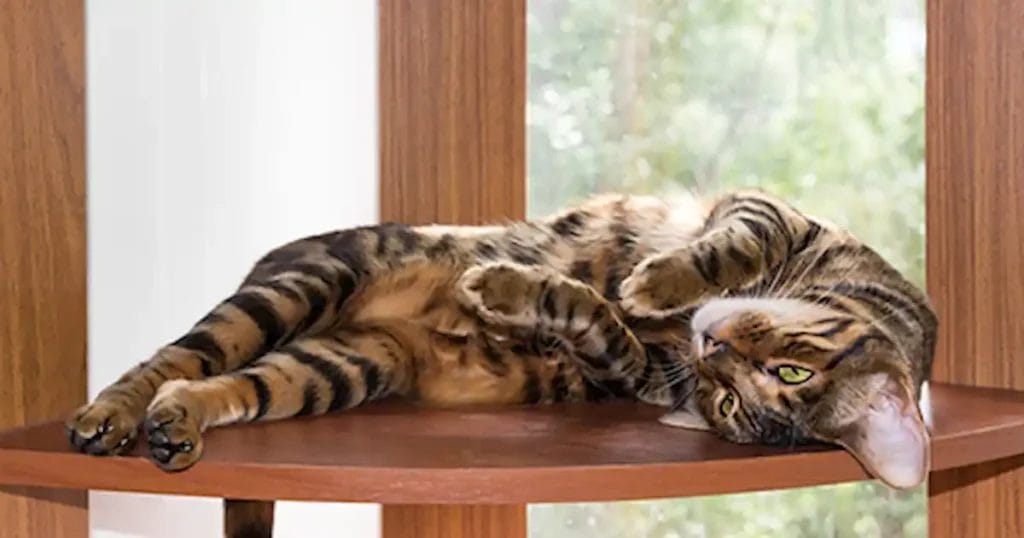The Toyger is a recently developed cat breed that has a markings and coat reminiscent of a tiny tiger. Created through careful breeding starting in the 1980s, these cats have a delightful personality to match their wild looks.
Introduction The Toyger Cat Breed
The Toyger cat is a relatively new domestic cat breed purposefully bred to resemble a small tiger starting in the 1980s. They first emerged in the United States through the efforts of cat breeder Judy Sugden. Have striped, orange coats accented by bright, white markings. These muscular cats typically weigh 10-15 pounds fully grown.

Affectionate with Family: ⭐⭐⭐⭐
Amount of Shedding: ⭐⭐
General Health: ⭐⭐⭐
Potential for Playfulness: ⭐⭐⭐⭐⭐
Tendency to Vocalize: ⭐⭐
Kid-Friendly: ⭐⭐⭐⭐
Friendly Toward Strangers: ⭐⭐⭐
Easy to Groom: ⭐⭐
Intelligence: ⭐⭐⭐
Pet Friendly: ⭐⭐⭐
Caring for a Toyger Cat Breed
- Food: High-protein kibble: Supports muscle development.
- Canned food: Provides moisture for urinary tract health. Treats: Positive rewards for training.
- Environment: Tall cat trees and shelves: Allows climbing and pouncing their prey drive. Scratching posts: Helps shed claws; sisal material is ideal. Safety-proofed: Their daring athleticism requires removing hazards.
- Grooming: Weekly brushing: Reduces shedding and keeps their coat lustrous. Bathing as needed: Keeps coat clean; medicated shampoos help skin issues. Claw trimming: Prevents overgrown, painful claws if scratching is inadequate.
- Care Methods: Interactive playtime with wand toys triggers their inner “tiger” hunting instincts.

Adopting/Buying a Toyger
- Locations: U.S. and U.K. are largest breeders; gaining popularity in other areas.
- Average Price: $800 to $1500 USD.
- Rescue Groups: Toyger Rescue, Carolina Toyger Connection.
What to Check Before Adoption/Purchase
- General Health: Confirm vet checkups scheduled regularly to find issues early.
- Vaccine Status: Kittens need 3 sets of core vaccines; then boosters per vet.
- Medical History: Ensure no genetic conditions passed from parents.
Preparing for a Toyger Cat
Cat-proof your home by removing loose items they could knock down and eliminating small spaces where they could get stuck. Set up scratching posts and cat trees for climbing/pouncing enrichment. Adhere to a routine feeding schedule to prevent begging.
- Essential Equipment: interactive wand toys that simulate prey, sisal scratching posts, enclosed litter box, kitten/cat food, grooming tools like brush and nail clippers.
- Common Diseases: Hypertrophic cardiomyopathy, hip dysplasia, certain hereditary conditions.
- Essential Vaccines: FVRCP, FeLV, rabies.

Toyger Cat Names
Give them fun, fierce names like those of big cats or jungle creatures. Some examples: Simba, Nala, Tiger, Leopard, Lion, Cheetah.
“Do Toyger cats like going outside rather than staying in?”
Both, but outdoor access needs supervision and containment for safety.
“Are Toyger cats smart?”
Yes, the breed is quite intelligent. Challenge their minds daily.
“How many types of Toyger cats?”
One Toyger breed with striped coat in shades of brown/black.
“How to stop Toyger cat biting?”
Say NO firmly and ignore them briefly. Provide plentiful chew toys.
“How to stop cat scratching?”
Use regular nail trims, cat scratchers, sisal scratch pads. Apply soft paws caps if necessary.
“How to socialize Toyger cats?”
Introduce them positively to new people, animals, places, sounds early and often to build confidence.
“How to train a Toyger cat?”
Use lots of rewards like praise, petting and treats to reinforce desired behavior. Engage their natural curiosity.
“How often should a Toyger cat see the vet?”
Annual exams until age 7, then twice yearly exams recommended.
“Are Toyger cats good family pets?”
Yes, with patience and effort for proper socialization. Expect energetic playtimes.
“Are cats good with kids?”
Usually, especially if raised with kids, properly introduced. Always supervise interactions.
“Are they good with other pets?”
Can be, though cautious intros are needed. Provide escape routes to avoid fights.
“Can they cause allergies?”
Moderate shedding means moderate potential for reactions in those with allergies. Regular bathing helps reduce allergens in their coat.
“Are cats aggressive?”
Generally no, though rough play could warrant training. Proper handling is important.
“Do cats have hair loss issues?”
Shedding is moderate, but stress may cause over-grooming and bald patches in some cats. Ensuring low stress helps prevent this issue.
Are you a cat lover who wants to learn more about your furry friends? Do you want to find the best cat food, cat care tips, and resources for your cats? If so, you’ve come to the right place! Welcome to Cat Food Site, the ultimate website for cat enthusiast.
Here you will find everything you need to know about cats Breed, from their health and behavior to their breeds, cat diet and names. You will also discover the latest cat news, cat nutrition, trends, and memes from around the web.

